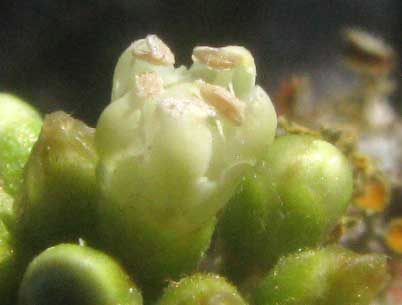Excerpts from Jim Conrad's
Naturalist Newsletter

from the July 21, 2013 Newsletter issued from the Frio Canyon Nature Education Center in the valley of the Dry Frio River in northern Uvalde County, southwestern Texas, on the southern border of the Edwards Plateau; elevation ~1750m (~5750 ft); N29.62°, W99.86°; USA
GUM BUMELIA
Nowadays on thin soil atop limestone bedrock a much-branched, thorny bush or small tree with distinctively small, simple leaves broader toward their tips than their bases occasionally is seen issuing globular clusters of tiny, white flowers, as shown above.
Though the flowers, only about 1/8th inch wide (3mm) are so small and simple that it's hard to make much of them, if you look very closely you do see something unusual, which is apparent below:

There you can barely make out the greenish calyx below the corolla's five white petals, as well as whitish stamens with their oblong anthers suspended above the flower's interior. It's the stamens' position that's unusual. For, in the vast majority of flowers with five calyx lobes, five petals, and five stamens, the corolla lobes arise between the calyx lobes, as they do in this flower, but also the stamens arise between the corolla lobes. In this blossom the stamens arise opposite the petals, not between them.
This is such an unusual feature that it considerably helps us narrow down the plant families the tree possibly could belong to. In our area, if you find a woody shrub or tree with flower parts in five, and the stamens are opposite the petals, the plant families that come to mind are the Buckthorn Family (Rhamnaceae), the Ebony Family (Ebonaceae), and the Sapodilla Family (Sapotaceae).
The Buckthorn Family holds the Hogplum we looked at awhile back, but that tree's flowers were very different. The Ebony Family is home to the Texas Persimmons we've looked at, but these aren't persimmon flowers, either. In fact, our spiny, roadside tree belongs to the Sapodilla Family. It's SIDEROXYLON LANUGINOSUM, known variously as Gum Bumelia, Gum Bully, Woollybucket Bumelia, Chittamwood, Gum Elastic and Coma.
In Mexico often we admired the Sapodilla Family because some of tropical America's most cherished fruit trees belong to this family. There's the Chicozapote or Sapodilla, Mamey, Star-apple or Caimito and Canistel, all trees providing deliciously sweet and juicy, fair-sized fruits. In phytogeographical terms, our roadside Gum Bumelia can be thought of as a runty representative of a predominantly tropical family trying to invade the northern Temperate Zone.
Like many of its cohorts, Gum Bumelia's fruits are edible and fairly good tasting, but they're so small that few people bother with them, only about 3/8ths of an inch long (1cm). However, such fruits, which are oval, blue to black berries, are perfect for birds and other critters.
The book Native American Food Plants: An Ethnobotanical Dictionary says that the Kiowa people used a "mucilaginous substance in the outer bark" as chewing gum. This sounds right, since in earlier times Mexico's Chicozapote or Sapodilla, in the same family, was the source of the latex from which the first chewing gum was made. Modern gum in the US is made from synthetic materials.